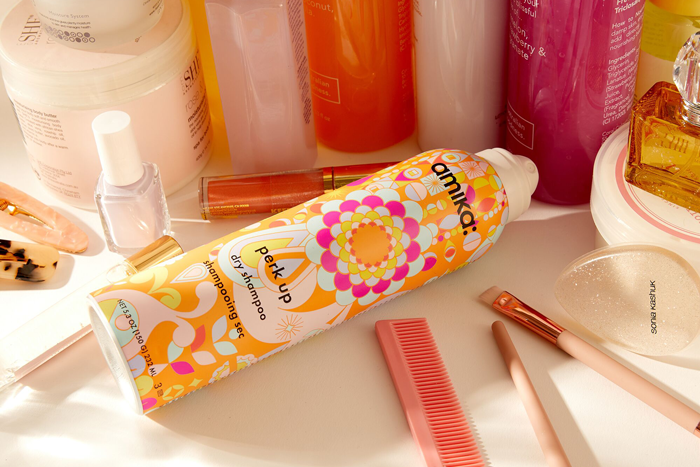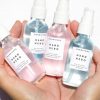
SUMMER 2020 EDITOR’S BOX PARTNER
If you are one of the millions of people currently working from home, the opportune moment for a hair detox has arrived. So should you do it? Product buildup, environmental pollution, and hard water — which can lead you with lackluster hair — say “yes.”
“To determine if a hair detox is for you, look at your hair. If it feels dry and pretty lifeless, you will need to take action,” explains celebrity hairstylist Paul Labrecque, founder of Paul Labrecque Salon & Skincare Spa. The health of your scalp also matters, particularly if you are experiencing dryness, flaking, or irritation.
If this is the case, a brief hair detox holds the answer to happier, healthier hair in the future. The key lies in tweaking your regimens to minimize water exposure, time spent drying, avoiding certain corrosive ingredients, and the incorporation of hair-health active ingredients. Celebrity hairstylist Jillian Halouska adds that a hair detox can be as simple as, “Laying off products and heat tools for a few days.” After all, as she points out, it’s not like we’re going anywhere anytime soon.
To guide you through the process, here are six tips to do a hair detox.
Check the ingredients in your shampoo and conditioner
“Today’s products are mostly plant-based, which makes them gentler on the hair,” begins Labrecque. “I recommend using a shampoo that is moisture-based and free of parabens and sulfates.” Sulfates are the suds-ing cleansers that leave you feeling ‘squeaky clean,’ but can be corrosive to the hair and scalp, stripping them of their natural protective oils that are responsible for long-term health. Parabens, such as methylparaben, are a class of synthetic preservatives that have been linked to hormone disruption, reproductive toxicity, and cancer.
Sulfate-free shampoos and moisture-rich conditioners are also key to preventing scalp dehydration, which actually cues more oil production (similarly to the skin on our faces). Labrecque adds that products with heavy waxes or alcohols can even clog the pores of your scalp, which is why many detoxifying treatments for the scalp incorporate activated charcoal — a natural detoxifying agent that binds to the toxins in our skin.
Tend to your scalp
Halouska points out that adding tea tree oil to any shampoo you own will detox not only your hair but also your scalp. If you suffer from frequent scalp irritation, dryness, or flaking, your scalp’s moisture barrier is compromised, which renders it vulnerable to irritants and environmental aggressors. Healing the barrier calls for a hiatus from stripping products, thermal drying, and exposure to common contact allergens (i.e. artificial fragrances, dyes, sulfates, chemical exfoliants, and parabens). Incorporating anti-inflammatory, nourishing, and detoxifying ingredients like CBD, manuka honey, and activated charcoal can all help you to detox and re-boot.
Don’t overwash
Paradoxically, a hair detox means taking a break from too frequent shampooing and exposure to hard water. “Over-cleansing hair and skin is a major mishap people make on a regular basis,” explains cosmetic dermatologist Dr. Whitney Bowe M.D. “When we over-cleanse using aggressive ingredients, it disrupts the scalp biome. So, we opt for expensive conditioners and leave-in treatments to try to mask the damage.” These products act as a band-aid for the problem but are not a comprehensive solution.
If your roots are looking limp and lackluster, you are struggling with an excess of oil, or you just want to freshen up after the gym, the amika Perk Up Dry Shampoo is a top-rated dry shampoo that you can use for touch-ups — but only in moderation. “I recommend washing your scalp when it’s dirty,” says Labrecque, explaining that your hair and scalp’s natural sebum is the best protection.
Moisture, moisture, moisture
“I don’t believe there is ever a time to go without products that are good for your hair or that provide moisture, [so] even if you detox your hair, don’t stop conditioning your strands!” warns Labrecque. He goes on to add that all hair types can benefit from added hydration, at all times. So, even if you skip out on your shampoo, hair spray, and blow-dry, do not discontinue your nourishing conditioners, frizz-fighting serums, or hydrating hair oils with nourishing botanicals.
Take a break from heat tools and styling
“Go easy on or eliminate heat appliances — they can really cause damage!” warns Labrecque. “Staying away from heat and accepting your hair’s natural movement, texture, and/or straightness is the key to great hair health.” As hard as it can be to go without blow-drying, flat-ironing, or curling, embracing your natural texture and letting your hair air dry is the way to go — and using a moisture-wicking hair towel will work wonders. The same goes for your hair spray, texturizers, and propane-powered sprays. “Certainly if you are a huge hair spray user, I would consider giving it a rest,” Labrecque chimes in.
Consider a supplement
One of our favorite ways to streamline our regimens of topical products is opting for supplements that nourish from within. If you are deficient in biotin, Labrecque recommends a supplement containing biotin to help yield improved hair health, growth, thickness, and more. Other ingredients to consider include the antioxidant amla (which can prevent hair loss), moisture-boosting ceramides (which prevent trans-epidermal moisture loss), the emollient collagen (which hydrates from within), and omega fatty acids.
xx, The FabFitFun Team
Psst! Have you signed up for FabFitFun yet? Don’t miss out on $200+ in amazing beauty, fitness, fashion, and lifestyle products, access to exclusive fitness and cooking content on FabFitFunTV, members-only sales, and more. Use code SUNFUN at checkout for 10% off your first box.
To get the most out of your box products, make sure to check out the Insider page.




